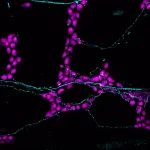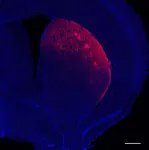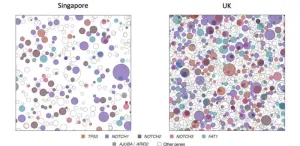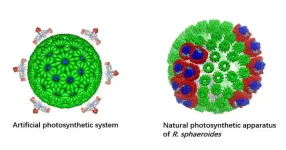(Press-News.org) LA JOLLA, CA—Gastrointestinal and digestive issues impact roughly 3 million people across the United States alone, and that number is growing. A new study from Scripps Research scientists shows how sensory neurons control our gastrointestinal tracts—critical information that could shape our understanding of related diseases and disorders.
The study, published in the journal Cell on Aug. 3rd, 2023, used a combination of human clinical data and animal models to reveal that the receptor PIEZO2 controls gastrointestinal transit through the stomach, small intestine, and colon by sensing the presence of food and slowing the rate of gut motility accordingly. These findings could lead to therapeutic applications for a range of gastrointestinal conditions, such as Inflammatory Bowel Disease and Irritable Bowel Syndrome.
“PIEZO2 plays a crucial role in gastrointestinal physiology and is necessary for normal gut function,” says senior author Ardem Patapoutian, PhD, professor in the Dorris Neuroscience Center at Scripps Research and a Howard Hughes Medical Institute investigator. Patapoutian received the 2021 Nobel Prize in Physiology for discovering that PIEZO2 and a related receptor, PIEZO1, are necessary for the cells to respond to mechanical stimuli. “Food and other ingested contents activate PIEZO2, which in turn dramatically slows gut transit.”
Gut transit time—the rate at which food moves through our gastrointestinal tracts—is essential for digestion, nutrient absorption and waste removal. Optimal digestion requires an optimal transit time: too slow, and you end up with constipation; too fast, and you risk diarrhea. Up until now, there’s been a limited understanding of how sensory pathways guide this process.
Patapoutian’s team decided to investigate whether sensory input from the receptor PIEZO2 plays a role in gut motility. PIEZO2 proteins are activated by mechanical forces or pressure and are found throughout the body, though their role in gastrointestinal motility has not been previously explored. PIEZO2 receptors are also involved in sensing the degree of lung inflation or bladder filling, so it made sense that these receptors might also be able to detect distension of the gastrointestinal tract.
“We wanted to understand the consequences of lacking this mechano-sensation and whether people without PIEZO2 have gastrointestinal problems,” says M. Rocio Servin-Vences, PhD, the study’s first author and a postdoctoral fellow in the Patapoutian lab at Scripps Research and the Howard Hughes Medical Institute.
Humans are sometimes—though rarely—born without functional PIEZO2 genes, and studying these individuals provides a window into the protein’s function. In collaboration with Alexander Chesler’s team at the National Institutes of Health (NIH), the researchers assessed the gastrointestinal health and medical history of a cohort of 12 humans, ranging in age from 9 to 42, who carried non-functional variants of the PIEZO2 gene.
Compared to members of the general population, the PIEZO2-deficient individuals reported a range of gastrointestinal dysfunctions including lumpy and watery stools. Notably, six of the individuals reported that they could not sense bowel movements, and five reported using medications to relieve gastrointestinal distress.
“The gastrointestinal dysfunction that these PIEZO2-deficient individuals described was striking,” says Servin-Vences. “It suggests that PIEZO2-deficient individuals have impaired sensation in bowel function that affects their quality of life, and also that the mechanosensitive channel PIEZO2 plays a crucial role in human gastrointestinal physiology and pathophysiology.”
To explore the mechanism behind how PIEZO2 governs gut physiology, the researchers next turned to animal models. They found that when PIEZO2 was removed from sensory neurons, the mice had much faster gut transit times, more frequent defecation and their stools had a higher water content.
“We were able to show that PIEZO2 is important for slowing down gastrointestinal transit,” says Servin-Vences. “When mice do not have PIEZO2 in these neurons, their gastrointestinal transit goes super fast, which has important consequences because it suggests that there is not enough time for proper nutrient absorption.”
Since PIEZO2 is expressed by multiple groups of neurons that innervate the gut, the researchers also wanted to pinpoint which neural pathway is responsible for controlling gut transit time. By using genetic and viral tools to selectively shut down PIEZO2 in two neural pathways—the nodose ganglia and dorsal root ganglia—the researchers were able to show that neurons in the dorsal root ganglia are exclusively responsible for controlling gut motility.
“It was very surprising that neurons from the dorsal root ganglia—but not from the nodose ganglia—have a homeostatic function in gut motility,” says Servin-Vences. “The nodose ganglia is known to regulate many functions in the gut, lungs and heart, whereas neurons from the dorsal root ganglia are more known for innervating the skin and detecting temperature and pain.”
The team also used fluorescent imaging to show that PIEZO2 control of gut motility occurs along the entire gastrointestinal tract—from stomach to small intestine to colon.
Though this is just an initial glimpse into how sensory neurons control gut motility, the researchers say it opens a slew of new research questions, and the possibility for future therapeutics. Servin-Vences says next steps are to assess how diet, lifestyle, stress and even microbiota affect this complicated system.
“In the long term, if we are able to find specific drugs that can either inhibit or stimulate the ion channel, we might be able to tune gut motility, which would have very important implications for gastrointestinal motility disorders,” says Patapoutian.
As well as Servin-Vences and Patapoutian, authors of the study “PIEZO2 in somatosensory neurons controls gastrointestinal transit,” include Alize Koolen, Yu Wang, Meaghan Loud, Suzanne Frausto, and Yunxiao Zhang of Scripps Research and the Howard Hughes Medical Institute; Ruby Lam of the Howard Hughes Medical Institute, Brown University, and the National Institutes of Health; Dimah Saade and Carsten Bönnemann of the Howard Hughes Medical Institute; Halil Kacmaz and Arthur Beyder of the Mayo Clinic and the Howard Hughes Medical Institute; Kara Marshal of the Baylor College of Medicine and the Jan and Dan Duncan Neurological Research Institute; and Alexander Chester of the Howard Hughes Medical Institute and the National Institutes of Health.
This study was funded by the Howard Hughes Medical Institute, the National Institutes of Health (grant R35 NS105067), the National Center for Complementary and Integrative Health, and the National Institute of Neurological Disorders and Stroke.
END
How sensory neurons impact the gut
Scripps Research scientists show that the receptor PIEZO2 in sensory neurons controls gut motility and transit time, which are important for digestion and nutrient absorption.
2023-08-03
ELSE PRESS RELEASES FROM THIS DATE:
Study finds hallmarks of T cell exhaustion within hours of tumor exposure
2023-08-03
Immune system T cells that should be able to kill cancer cells become dysfunctional or “exhausted” within hours of encountering a tumor, according to a study reported Aug. 3 in Nature Immunology.
The surprising findings have implications for cancer immunotherapies that aim to harness the tumor-killing power of T cells, and they challenge existing ideas about how T cells become exhausted, said Mary Philip, MD, PhD, assistant professor of Medicine in the Division of Hematology and Oncology ...
New research casts doubt on role of fungus in driving pancreatic cancer
2023-08-03
DURHAM, N.C. – Four years ago, a report that a common species of fungus might fuel pancreatic cancer offered a promising new view of the deadly disease.
But in working to validate the finding, Duke Health researchers have found no such association. In a study appearing online Aug. 3 in the journal Nature, the Duke researchers conducted a multi-pronged analysis of data from the earlier study and found no link between the pancreatic microbiome and the development of pancreatic cancer.
“We were intrigued by the original finding, as were ...
Dopamine controls movement, not just rewards
2023-08-03
Dopamine: It’s not just for rewards anymore.
In a new Northwestern University-led study, researchers identified and recorded from three genetic subtypes of dopamine neurons in the midbrain region of a mouse model.
Although there is a long-standing, common assumption that most — if not all — dopamine neurons solely respond to rewards or reward-predicting cues, the researchers instead discovered that one genetic subtype fires when the body moves. And, even more surprisingly, these neurons curiously do not respond to rewards at all.
Not only ...
Study uncovers epigenetic source of resistance to targeted therapy in EGFR-mutant lung cancer
2023-08-03
RESEARCH SUMMARY
Study Title: Mammalian SWI/SNF chromatin remodeling complexes promote tyrosine kinase inhibitor resistance in EGFR-mutant lung cancer
Publication: Cancer Cell
Dana-Farber Cancer Institute Senior and Lead Authors: Cigall Kadoch, PhD; Claudia Gentile, PhD; Akshay Sankar
Study Summary:
When lung cancers driven by mutations in the EGFR gene become resistant to osimertinib or other targeted therapies, epigenetic changes, rather than genetic changes, are often to blame. In a new study in Cancer Cell, researchers at the Dana-Farber Cancer Institute and Yale Cancer Center show that the main source of these changes are ...
Past climate warming driven by hydrothermal vents
2023-08-03
About 55 million years ago, the Atlantic Ocean was born. Until then, Europe and America were connected. As the continents began to move apart, the Earth’s crust between them ruptured, releasing large volumes of magma. This rift volcanism has led to the formation of large igneous provinces (LIPs) in several places around the world. One such LIP was formed between Greenland and Europe and now lies several kilometres below the ocean surface. An international drilling campaign led by Christian Berndt from the GEOMAR ...
James Webb Space Telescope captures stunning images of the Ring Nebula
2023-08-03
NASA's James Webb Space Telescope (JWST) has recorded breath-taking new images of the iconic Ring Nebula, also known as Messier 57.
The images, released today by an international team of astronomers led by Professor Mike Barlow (UCL, UK) and Dr Nick Cox (ACRI-ST, France), with Professor Albert Zijlstra of The University of Manchester, showcase the nebula's intricate and ethereal beauty in unprecedented detail, providing scientists and the public with a mesmerizing view of this celestial wonder.
For many sky enthusiasts, the Ring Nebula is a well-known object that is visible all summer long and is located in the constellation ...
Wellcome Sanger Institute: Skin cancer-related mutations higher in the UK than Singapore
2023-08-03
SKIN CANCER-RELATED MUTATIONS HIGHER IN THE UK THAN SINGAPORE
A new study has shown how, on average, people in the UK have facial skin that is far more DNA damaged from the sun than people in Singapore, explaining the far higher risk of developing the most common skin cancers in the UK.
This study looked at keratinocyte cancers - basal and squamous cell carcinomas - rather than melanoma, a rarer and sometimes fatal form of skin cancer, finding Northern European skin types in the UK were less able to protect themselves from UV damage.
Researchers from the Wellcome Sanger Institute and their collaborators at ...
Researchers release action plan to boost diversity in postgraduate science students
2023-08-03
UK researchers are calling on higher education institutes and research funders to adopt a new set of recommended actions to address the substantial under-representation of PhD students from ethnic minority backgrounds.
Black, Asian and minority ethnic students have a markedly lower representation in postgraduate research compared with undergraduate or taught postgraduate study in the UK. For instance, in 2020/21, around 26.5% of UK undergraduates were from ethnic minority backgrounds, compared with around 19% for postgraduate students.
The ...
New photocatalytic system converts carbon dioxide to valuable fuel more efficiently than natural photosynthesis
2023-08-03
A joint research team from City University of Hong Kong (CityU) and collaborators recently developed a stable artificial photocatalytic system that is more efficient than natural photosynthesis. The new system mimics a natural chloroplast to convert carbon dioxide in water into methane, a valuable fuel, very efficiently using light. This is a promising discovery, which could contribute to the goal of carbon neutrality.
Photosynthesis is the process by which chloroplasts in plants and some organisms use sunlight, water and carbon dioxide to create food or energy. In past decades, many scientists have tried to develop artificial photosynthesis processes to turn ...
Association of pregnancy-specific alcohol policies with infant morbidities and maltreatment
2023-08-03
About The Study: In this study of 1.4 million birthing person–infant pairs in the U.S., most pregnancy-specific alcohol policies were not associated with decreased odds of infant injuries or morbidities. Policy makers should not assume that pregnancy-specific alcohol policies improve infant health.
Authors: Sarah C. M. Roberts, Dr.P.H., of the University of California, San Francisco, is the corresponding author.
To access the embargoed study: Visit our For The Media website at this link https://media.jamanetwork.com/
(doi:10.1001/jamanetworkopen.2023.27138)
Editor’s ...
LAST 30 PRESS RELEASES:
UMass Amherst chemists develop unique tool for studying RNA
Disappointment alters brain chemistry and behavior
A built-in odometer: new study reveals how the brain measures distance
Stress-related brain signals drive risk of cardiovascular disease in people with depression and anxiety
New details on role of fat transport molecules in Alzheimer’s onset
Study illuminates how an antiviral defense mechanism may lead to Alzheimer’s disease
Spot the males: New gene-editing method could transform mosquito control
AI learns to build simple equations for complex systems
NAU team releases 13 years of detailed U.S. CO2 emissions data
Unveiling how sodium-ion batteries can charge faster than lithium-ion ones
How do childcare tax credits affect children’s long-term health?
Can an electronic nose detect indoor mold?
Do natural disasters have long-term impacts on mortality in older adults?
Modification improves sodium‐ion batteries as an alternative to lithium-ion batteries
Parasports provide a range of benefits for people with cerebral palsy
How does grandparental care affect children’s health?
Why are there so many Nordic mediators?
Young shark species more vulnerable to extinction
Mobile fetal heart monitoring linked to fewer newborn deaths in Tanzania
Bluey’s dad offered professorial chair in archaeology at Griffith University
Beyond small data limitations: Transfer learning-enabled framework for predicting mechanical properties of aluminum matrix composites
Unveiling non-thermal catalytic origin of direct current-promoted catalysis for energy-efficient transformation of greenhouse gases to valuable chemicals
Chronic breathlessness emerging as a hidden strain on hospitals
Paleontologists find first fossil bee nests made inside fossil bones
These fossils were the perfect home for ancient baby bees
Not everyone reads the room the same. A new study examines why.
New research identifies linked energy, immune and vascular changes in ME/CFS
Concurrent frailty + depression likely boost dementia risk in older people
Living in substandard housing linked to kids’ missed schooling and poor grades
Little awareness of medical + psychological complexities of steroid cream withdrawal
[Press-News.org] How sensory neurons impact the gutScripps Research scientists show that the receptor PIEZO2 in sensory neurons controls gut motility and transit time, which are important for digestion and nutrient absorption.






